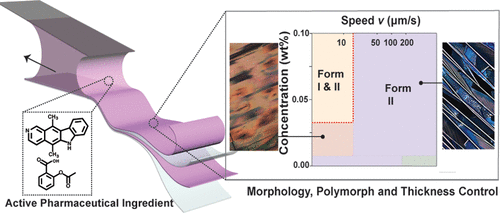当前位置:
X-MOL 学术
›
ACS Appl. Mater. Interfaces
›
论文详情
Our official English website, www.x-mol.net, welcomes your feedback! (Note: you will need to create a separate account there.)
Solution Coating of Pharmaceutical Nanothin Films and Multilayer Nanocomposites with Controlled Morphology and Polymorphism
ACS Applied Materials & Interfaces ( IF 9.5 ) Pub Date : 2018-03-08 00:00:00 , DOI: 10.1021/acsami.8b01074 Elizabeth M. Horstman 1 , Prapti Kafle 1 , Fengjiao Zhang 1 , Yifu Zhang 1 , Paul J. A. Kenis 1 , Ying Diao 1
ACS Applied Materials & Interfaces ( IF 9.5 ) Pub Date : 2018-03-08 00:00:00 , DOI: 10.1021/acsami.8b01074 Elizabeth M. Horstman 1 , Prapti Kafle 1 , Fengjiao Zhang 1 , Yifu Zhang 1 , Paul J. A. Kenis 1 , Ying Diao 1
Affiliation

|
Nanosizing is rapidly emerging as an alternative approach to enhance solubility and thus the bioavailability of poorly aqueous soluble active pharmaceutical ingredients (APIs). Although numerous techniques have been developed to perform nanosizing of API crystals, precise control and modulation of their size in an energy and material efficient manner remains challenging. In this study, we present meniscus-guided solution coating as a new technique to produce pharmaceutical thin films of nanoscale thickness with controlled morphology. We demonstrate control of aspirin film thickness over more than 2 orders of magnitude, from 30 nm to 1.5 μm. By varying simple process parameters such as the coating speed and the solution concentration, the aspirin film morphology can also be modulated by accessing different coating regimes, namely the evaporation regime and the Landau–Levich regime. Using ellipticine—a poorly water-soluble anticancer drug—as another model compound, we discovered a new polymorph kinetically trapped during solution coating. Furthermore, the polymorphic outcome can be controlled by varying coating conditions. We further performed layer-by-layer coating of multilayer nanocomposites, with alternating thin films of ellipticine and a biocompatible polymer, which demonstrate the potential of additive manufacturing of multidrug-personalized dosage forms using this approach.
中文翻译:

具有受控形态和多态性的药物纳米薄膜和多层纳米复合材料的溶液涂层
纳米化正在迅速出现,作为提高溶解度并因此提高水溶性差的活性药物成分(API)的生物利用度的替代方法。尽管已开发出许多技术来执行API晶体的纳米化,但以节能和高效材料的方式精确控制和调节其尺寸仍然具有挑战性。在这项研究中,我们介绍半月板引导溶液涂层作为一种新技术,以生产具有可控形态的纳米级厚度的药物薄膜。我们证明了阿司匹林薄膜厚度的控制范围超过2个数量级,从30 nm到1.5μm。通过更改简单的工艺参数(例如涂布速度和溶液浓度),还可以通过使用不同的涂布方式来调节阿司匹林薄膜的形态,即蒸发状态和Landau-Levich状态。使用玫瑰树碱(一种水溶性较差的抗癌药物)作为另一种模型化合物,我们发现了在溶液包衣过程中会动态捕获的一种新的多晶型物。此外,可以通过改变包衣条件来控制多晶型结果。我们进一步用玫瑰树碱和生物相容性聚合物交替进行多层纳米复合材料的逐层包衣,这证明了使用这种方法可加成制造多种药物个性化剂型的潜力。
更新日期:2018-03-08
中文翻译:

具有受控形态和多态性的药物纳米薄膜和多层纳米复合材料的溶液涂层
纳米化正在迅速出现,作为提高溶解度并因此提高水溶性差的活性药物成分(API)的生物利用度的替代方法。尽管已开发出许多技术来执行API晶体的纳米化,但以节能和高效材料的方式精确控制和调节其尺寸仍然具有挑战性。在这项研究中,我们介绍半月板引导溶液涂层作为一种新技术,以生产具有可控形态的纳米级厚度的药物薄膜。我们证明了阿司匹林薄膜厚度的控制范围超过2个数量级,从30 nm到1.5μm。通过更改简单的工艺参数(例如涂布速度和溶液浓度),还可以通过使用不同的涂布方式来调节阿司匹林薄膜的形态,即蒸发状态和Landau-Levich状态。使用玫瑰树碱(一种水溶性较差的抗癌药物)作为另一种模型化合物,我们发现了在溶液包衣过程中会动态捕获的一种新的多晶型物。此外,可以通过改变包衣条件来控制多晶型结果。我们进一步用玫瑰树碱和生物相容性聚合物交替进行多层纳米复合材料的逐层包衣,这证明了使用这种方法可加成制造多种药物个性化剂型的潜力。


























 京公网安备 11010802027423号
京公网安备 11010802027423号